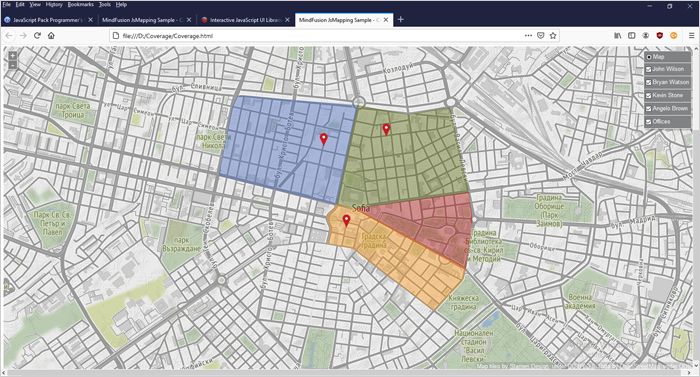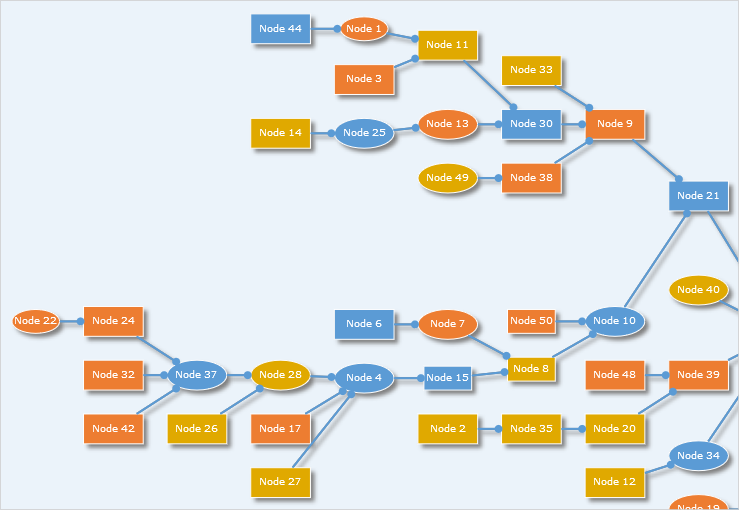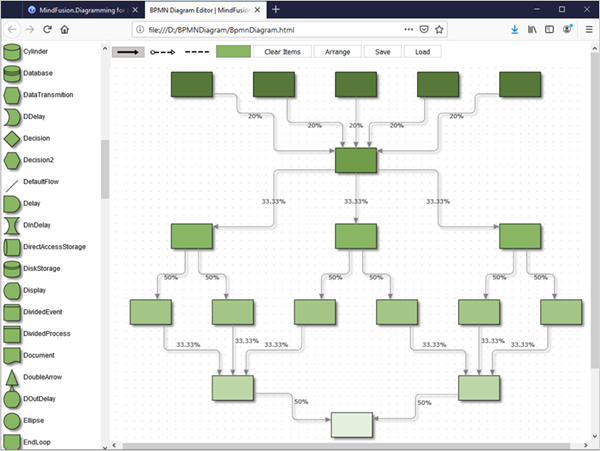In this blog post we are going to use the CanvasLayer of the JavaScript map library to build a web page that renders a city map with overlay polygons of the districts, covered by various couriers of a company. Each area is a separate in different color. Here is the final result:
Author Archives: Slavcho
Area Chart in Java Swing
In this blog post we are going to show you how to build this beautiful area chart with two series. We use MindFusion charting library for Java Swing and the AreaChart control that is part of it.
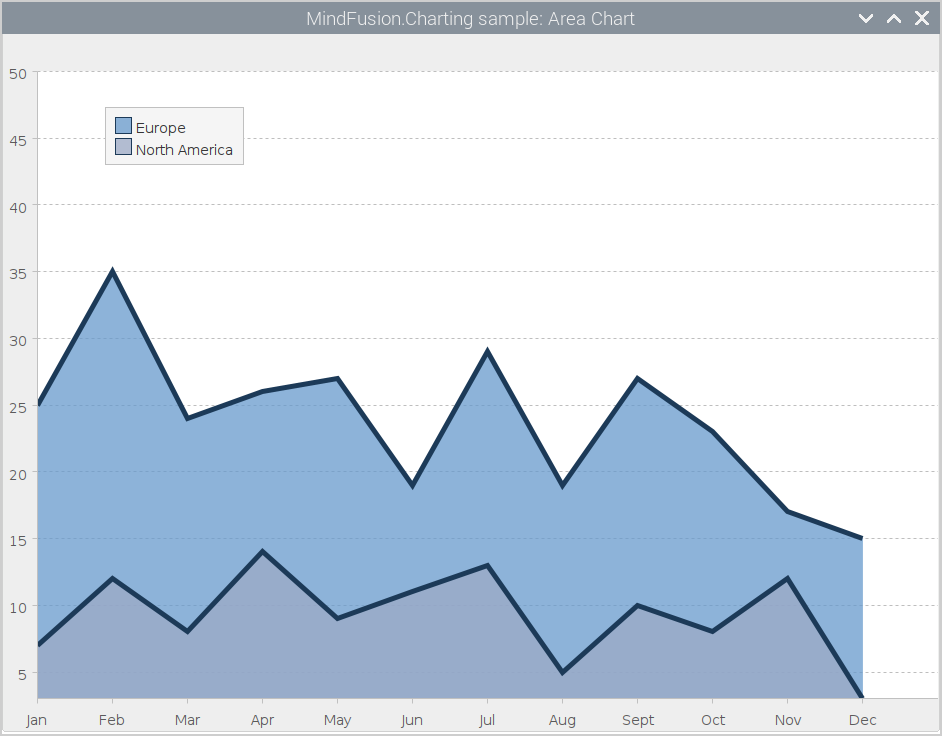
Pan and Zoom Programmatically in a JavaScript Diagram
We will build a diagram with 50 random nodes and we will zoom and pan this diagram programmatically. Here is a screenshot of the final diagram, which is a link to the sample:
We will use the MindFusion Diagramming library for JavaScript.
I. Project Setup
We add a reference to the MindFusion.Diagramming.js and MindFusion.Common.js files. We also add a reference to another file called MouseEvents.js. This is our code-behind file.
<script src="MindFusion.Common.js" type="text/javascript"></script> <script src="MindFusion.Diagramming.js" type="text/javascript"></script> <script src="MouseEvents.js" type="text/javascript"></script>
In the BODY of the web page we create a Canvas element, to which we assign an id. This is important, because we will refer to the Canvas in code:
<div style="width: 100%; height: 100%; overflow: auto;">
<canvas id="diagram_canvas" width="2100" height="2100">
This page requires a browser that supports HTML 5 Canvas element.
</canvas>
</div>
II. Diagram Settings
In the code-behind file that we called MouseEvents.js we use the DOMContentLoaded event to initialize the diagram.
document.addEventListener("DOMContentLoaded", function ()
{
// create a Diagram component that wraps the "diagram_canvas" canvas
diagram = MindFusion.AbstractionLayer.createControl(Diagram, null, null, null, document.getElementById("diagram_canvas"));
diagram.setBounds(new Rect(5, 5, 2000, 1000));
We use the createControl method of the AbstractionLayer class to create an instance of the Diagram class. The setBounds method determines the size of the diagram’s drawing area. If this size is bigger than the size of the Canvas, the diagram automatically shows scrollbars. Note that only if the diagram’s area is larger than the canvas we can use panning.
We use some settings of the Diagram class to customize the application:
diagram.setDefaultShape("Rectangle");
diagram.setRouteLinks(true);
diagram.setRoundedLinks(true);
diagram.setShowGrid(false);
The links will be routed and rounded and no grid will be rendered.
III. Diagram Items
We create the diagram nodes with the createShapeNode method of the Factory class. The Factory class as an instance is available through the getFactory() method:
for(var i = 0; i < 50; i++)
{
var colorIndex = Math.floor(Math.random() * 3);
var shape = diagram.getFactory().createShapeNode(new Rect(136, 36, 20, 10));
shape.setBrush({ type: 'SolidBrush', color: colors[colorIndex] });
if(i % 3 == 0)
shape.setShape('Ellipse');
else
shape.setShape('Rectangle');
if( i % 7 == 0)
{
shape.setBounds(new Rect(136, 36, 16, 8));
}
shape.setText("Node " + (i + 1).toString());
shape.setTextColor("white");
}
We make each third shape Ellipse and we choose the brush on a random principle out of three brushes, that we initialized in an array. Each seventh shape is slightly smaller – that is set with the setBounds method, which takes as an argument a Rect, that is slightly smaller than the Rect instance that we use when we create the shape nodes.
The connectors among the nodes are created with the createDiagramLink method of Factory . We cycle through all 50 nodes and connect each one of them with a randomly taken node from the diagram nodes collection. This collection is available through the nodes proeprty of the Diagram class:
diagram.nodes.forEach(function(node)
{
var nodeIndex = Math.floor(Math.random() * 50);
var node2 = diagram.nodes[nodeIndex];
var link = diagram.getFactory().createDiagramLink(node, node2);
link.setHeadShape("Circle");
})
We customize the appearance of the link through the setHeadShape method. We choose the ‘Circle’ shape as a head to each link.
We have created the diagram items with the same bounds, which means they are on top of each other. The best way to arrange them is with one of the automatic layout algorithms, available with the JsDiagram. They are members of the MindFusion.Graphs namespace – you can check the rest. In our sample we’ve chosen the LayeredLayout ,which provides quite nice result. We set its direction to LayoutDirection .There a few other properties that we’ve set that regulate the node distance, the layer distance and more:
var layout = new MindFusion.Graphs.LayeredLayout(); layout.direction = MindFusion.Graphs.LayoutDirection.LeftToRight; layout.siftingRounds = 0; layout.nodeDistance = 8; layout.layerDistance = 8; diagram.arrange(layout);
All layouts are applies through the arrange method of the Diagram that takes an instance of the layout as an argument.
IV. Pan and Zoom
We will implement pan and zoom by handling standard DOM events. The first one is the “wheel” event, which we attach to the diagram canvas element:
var dgrm = document.getElementById('diagram_canvas');
dgrm.addEventListener('wheel', function(e)
{
var zoom = diagram.getZoomFactor();
zoom -= e.deltaY / 10;
if (zoom > 10)
diagram.setZoomFactor(zoom);
e.preventDefault(); // do not scroll
});
We use the getZoomFactor and setZoomFactor methods of the Diagram , to manipulate the zoom ratio. The zoom step is calculated based on the deltaY value of the event args. You can command the amount of zoom by dividing by a smaller or a larger number. It is important that we call preventDefault() on the event arguments, to surpass the default response of the canvas to the wheel event.
The panning is implemented by handling the mousedown and mouseup DOM events of the Canvas.
/* events fired on the draggable target */
dgrm.addEventListener('mousedown', function(e)
{
if( e.ctrlKey)
diagram.setBehavior(MindFusion.Diagramming.Behavior.Pan);
}, false);
dgrm.addEventListener('mouseup', function(e)
{
if( e.ctrlKey)
diagram.setBehavior(MindFusion.Diagramming.Behavior.LinkShapes);
}, false);
If we want to make the Diagram pan we need simply to change the diagram’s behavior with the setBehavior method. The options are members of the Behavior enumeration. When the user clicks on the Diagram and the Ctrl key is pressed, we change the diagram’s behavior to “Pan”. When the mouse is up, but the Ctrl key is pressed, we rest the behavior back to LinkShapes. This is the default behavior, where dragging with the mouse creates new shapes, while dragging between existing DiagramShape -s, creates DiagramLink -s.
With that our sample is ready. You can download the source code from this link:
Download the Mouse Events Sample with JavaScript Diagram
Technical support is available through MindFusion forum here.
About Diagramming for JavaScript: This native JavaScript library provides developers with the ability to create and customize any type of diagram, decision tree, flowchart, class hierarchy, graph, genealogy tree, BPMN diagrams and much more. The control offers rich event set, numerous customization options, animations, graph operations, styling and themes. You have more than 100 predefined nodes, table nodes and more than 15 automatic layout algorithms. Learn more about Diagramming for JavaScript at https://mindfusion.eu/javascript-diagram.html.
Tree with Nodes that Have Multiple Parents
Most tree structures are built as hierarchies: the number of nodes increases at each level. In our sample we will look at a tree, where not all branches have a higher number of nodes than their predecessors. In our tree some nodes will have multiple parents e.g. there are nodes that have several ancestors.
You can try the sample online:
In order to build this application we use MindFusion Diagramming for JavaScript library.
I. General Settings
In a web page we add the code that initializes a Canvas. We give the Canvas an id:
<div style="overflow: visible; height: 100%; margin: 1px; padding: 0px;">
<canvas id="diagram" width="2100" height="2500">
This page requires a browser that supports HTML 5 Canvas element.
</canvas>
</div>
We add references to the two JavaScipt files that provide the diagramming functionality: MindFusion.Diagramming and MindFusion.Common. We also add a reference to a code-behind file that contains the JavaScript code for our application:
<script src="Scripts/MindFusion.Common.js" type="text/javascript"></script> <script src="Scripts/MindFusion.Diagramming.js" type="text/javascript"></script> <script src="MultipleParentNodes.js" type="text/javascript"></script>
We have placed those files in a subfolder called Scripts, which is located in our main application folder.
II. Diagram Settings
We create the diagram in the window.onload event handler. We want to be sure that all scripts are loaded:
window.onload = function(e)
{
var diagramEl = document.getElementById('diagram');
// create a Diagram component that wraps the "diagram" canvas
diagram = AbstractionLayer.createControl(Diagram, null, null, null, diagramEl);
diagram.setAllowInplaceEdit(true);
diagram.setRouteLinks(true);
diagram.setShowGrid(true);
diagram.setRoundedLinks(true);
diagram.setBounds(new Rect(0, 0, 2000,2500));
}
We create the Diagram using a reference to the DOM element of the Canvas from the web page. We set its allowInplaceEdit property to true, which lets users edit interactively nodes and links. We use showGrid to render a background grid that helps to align nodes and links. We setRoundedLinks and give the diagram a big work are with the setBounds method.
II. Creating the Diagram Nodes
We create the DiagramNode -s in a separate method, which we call after the control is created and all settings are made:
function onLoaded()
{
var nodes = {};
for(var i = 0; i < 5; i++)
{
nodes[i] = diagram.getFactory().createShapeNode(new Rect(20, 20, 20, 12));
nodes[i].setShape('Rectangle');
nodes[i].setBrush({ type: 'SolidBrush', color: '#567939' });
};
We initialize a list, where we will store dynamically those nodes that we want to have reference to. At first we create 5 ShapeNode -s that are the first level of the tree. We use the createShapeNode method of Factory to create the ShapeNode -s and DiagramLink -s. Note that we will create all nodes with equal bounds. We don’t have to worry about their location because we will apply an automatic layout at the end.
Factory is available through the getFactory method of Diagram You do not usually create the class but get an instance of it through the Diagram instance.
We use setShape to provide the id af the diagram shape that we want the node to take. A list with the diagram shapes available, together with their id-s can be found in the online help.
We also use setBrush to specify the fill of the ShapeNode . In our case we use a SolidBrush ,but there are other options to choose from.
We create then a single ShapeNode that will be the next level:
var node5 = diagram.getFactory().createShapeNode(new Rect(20, 20, 20, 12 ));
node5.setShape('Rectangle');
node5.setBrush({ type: 'SolidBrush', color: '#6f9c49' });
We color it in a slightly lighter shade of green than the nodes at the first level. We then use the Factory class once again to create the DiagramLink -s between the 5 nodes at the first level and this one single node at the second level:
for(var i = 0; i < 5; i++)
{
var link = diagram.getFactory().createDiagramLink(nodes[i], node5);
link.setHeadShape("Triangle");
link.setText("20%");
link.setHeadShapeSize(3.0);
link.setHeadBrush({ type: 'SolidBrush', color: '#7F7F7F' });
};
The setText and setHeadShape methods of the DiagramLink class allow us to specify the label of the link and its shape at the end. There is also setBaseShape that allows us the specify the shape at the start of the DiagramLink.
The lovely thing about the Factory class is that it adds automatically the newly created DiagramItem -s, such as nodes and links, to the items collection of the diagram. You can find the newly created DiagramNode -s and DiagramLink -s also as members of the nodes and links collections respectively.
Now we have 5 links coming from all 5 nodes from the first level that point to the second level:
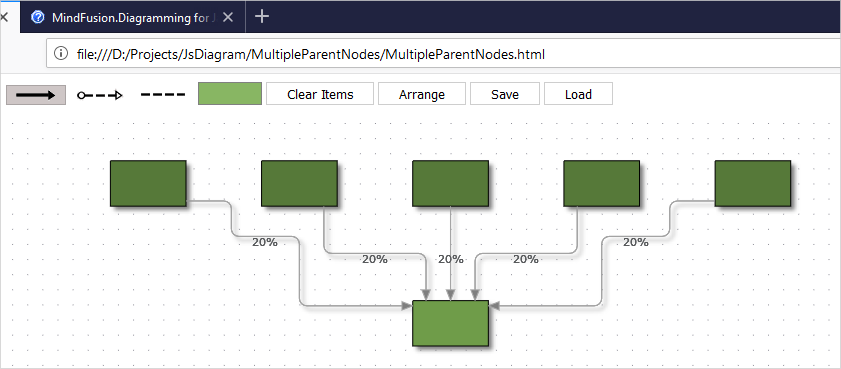
We go on doing the rest of the diagram in the same way. We create ShapeNode -s with Factory and then bind the nodes with Factory .
III. Layout
We use the LayeredLayout to arrange all nodes of the diagram. Since the diagram is not a typical tree, we prefer the LayeredLayout to the TreeLayout
var lLayout = new MindFusion.Graphs.LayeredLayout(); diagram.arrange(lLayout);
It is really easy to apply any other algorithm on the diagram – you just need to create an instance of it and call the arrange method of your diagram to apply this instance. You can quickly change layouts and experiment to see which one provides the best result.
In our case the LayeredLayout looks fine and with this we are done building the tree.
You can download the sample together with all libraries used from the following link:
A JavaScript Graph with Nodes that Have Multiple Parents
Technical support is available through MindFusion forum here.
About Diagramming for JavaScript: This native JavaScript library provides developers with the ability to create and customize any type of diagram, decision tree, flowchart, class hierarchy, graph, genealogy tree, BPMN diagrams and much more. The control offers rich event set, numerous customization options, animations, graph operations, styling and themes. You have more than 100 predefined nodes, table nodes and more than 15 automatic layout algorithms. Learn more about Diagramming for JavaScript at https://mindfusion.eu/javascript-diagram.html.
Different-size Icons in the Js Diagram NodeListView
In this blog post we will learn how to add a NodeListView control to a Diagram and how to set its ShapeNode -s to a different size. When ShapeNode -s are dragged from the NodeListView the instances that will be created are proprtional in size to the size of the ShapeNode that was dragged. Here is a screenshot of the final application:
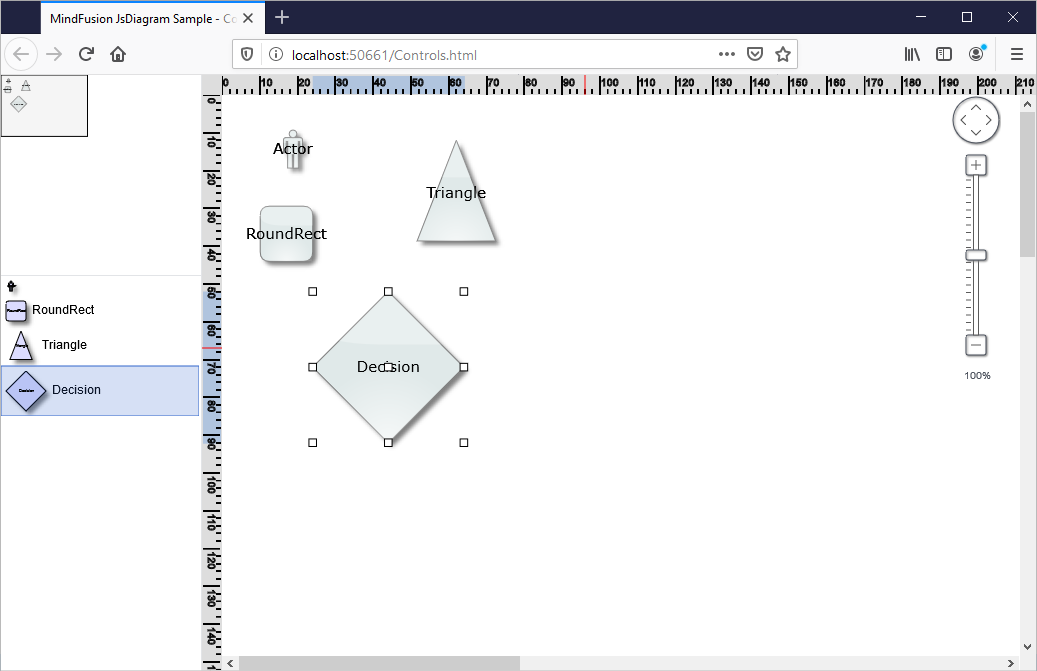
I. General Settings
We create an HTML page and add to it references to the MindFusion JavaScript files that represent the diagramming library:
<script src="MindFusion.Common.js" type="text/javascript"></script> <script src="MindFusion.Diagramming.js" type="text/javascript"></script> <script src="Controls.js" type="text/javascript"></script>
The last reference is to the Controls JavaScript file, where the code for the application is located.
Then we create two Canvas-es: one is for the NodeListView and the other is for the Diagram The NodeListView component is bound to the canvas element below:
<div style="width: 200px; height: 100%; overflow-y: auto; overflow-x: hidden; position: absolute; top: 201px; left: 0px; right: 0px; bottom: 0px;"> <canvas id="nodeList" width="200"></canvas>
</div>
......
<!-- The Diagram component is bound to the canvas element below --> <div style="position: absolute; left: 0px; top: 0px; right: 0px; bottom: 0px; overflow: auto;"> <canvas id="diagram" width="2100" height="2100">
This page requires a browser that supports HTML 5 Canvas element.
</canvas>
</div>
Both the Diagram and NodeListView controls require Canvas elements to render themselves onto.
II. Initializing the Controls
We create the Diagram using the id that we’ve provided to its Canvas in the web page:
// create a Diagram component that wraps the "diagram" canvas
diagram = Diagram.create(document.getElementById("diagram"));
diagram.setBounds(new MindFusion.Drawing.Rect(0, 0, 500, 500));
We set a bigger size to the diagram in order to make it fill the web page.
We create the NodeListView instance the same way we created the diagram:
// create a NodeListView component that wraps the "nodeList" canvas
var nodeList = MindFusion.Diagramming.NodeListView.create(document.getElementById("nodeList"));
nodeList.setTargetView(document.getElementById("diagram"));
Now we need to add the settings that will make the ShapeNode -s different in size when rendered onto the list:
nodeList.setIconSize(null);
The setIconSize method is used to specify the default size of nodes in the NodeListView When we set the size to null, the control draws each node in the NodeListView with the size that was assigned to it:
function initNodeList(nodeList, diagram)
{
// add some nodes to the NodeListView
var shapes = ["Actor", "RoundRect", "Triangle", "Decision"];
for (var i = 0; i < shapes.length; ++i)
{
var node = new MindFusion.Diagramming.ShapeNode(diagram);
node.setText(shapes[i]);
node.setShape(shapes[i]);
node.setBounds(new MindFusion.Drawing.Rect(0, 0, (i+1)*10, (i+1)*10));
nodeList.addNode(node, shapes[i]);
}
}
Here we increase the size of wach ShapeNode with 10 points on each itereation. This makes the icons with various size but does not create them with different size when dropped on the diagram. In order to do this we must set:
nodeList.setDefaultNodeSize (null);
setDefaultNodeSize specifies the size of those nodes that are created when a ShapeNode is dropped on the Diagram area. By setting this size to null we tell the control to read the size of the new ShapeNode from the instance in the NodeListView control.
With that our sample is ready. You can download the source code from this link:
JavaScript NodeListView with Various Size Nodes: Download Sample
About Diagramming for JavaScript: This native JavaScript library provides developers with the ability to create and customize any type of diagram, decision tree, flowchart, class hierarchy, graph, genealogy tree and more. The control offers rich event set, numerous customization options, animations, graph operations, styling and themes. You have more than 100 predefined nodes, table nodes and more than 15 automatic layout algorithms. Learn more about Diagramming for JavaScript at https://mindfusion.eu/javascript-diagram.html.

